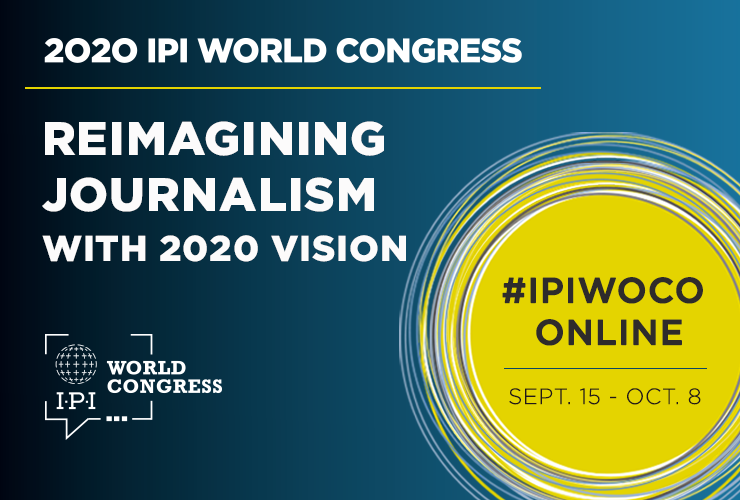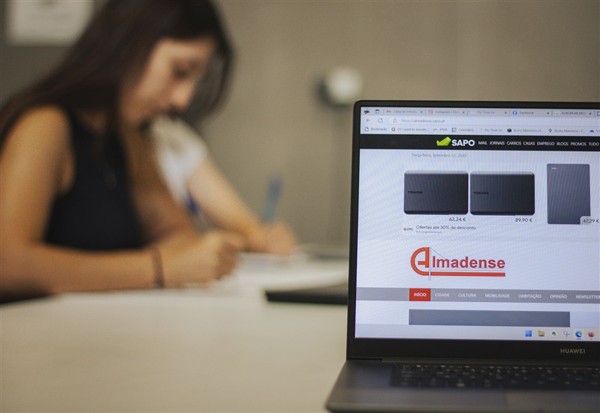On Tuesday, the International Press Institute (IPI) kicked off its virtual World Congress 2020 with three expert talks featuring leading journalists, editors and media executives from around the world discussing challenges facing the media industry and journalism in the digital age.
Day one of IPIWoCo saw three online webinars focus on different aspects of how the transition from print to online media had radically transformed news, drove innovation and forced journalists to adapt to a host of fresh challenges for the industry and its journalists.
Building Sustainable News Media in a Digital Age
The first event brought together Gary Liu, Chief Executive Officer of the Hong Kong-based South China Morning Post and Lauren Williams, Senior Vice President and Editor-in-Chief at Vox & Recode to discuss how to build sustainable news media in a digital age.
The pair agreed that while the digital age has radically transformed journalism over the last two decades and democratized the flow of information, building a sustainable business model in an oversaturated market had brought new tests.
“Fear of mass unsubscriptions, political interventions and advertisers are just some of the dangers to the pursuit of truth, journalistic accountability and the uncovering of wrongs,” said Williams.
Launched in 2014, Vox transformed the newspaper model to coexist with competitors and offer users something different through “promoting the idea that the news is not necessarily the most important part of the story,” explained Williams, “but rather the context”.
With its successful explainer product, Williams said that digital publisher maintains a diversified revenue model including advertising and branded content across a variety of platforms using digital, audio and video.
Comscore recently ranked Vox Media as the 32nd most popular media company, and the contributors program, launched in response to the pandemic earlier this year, “turned out to be a success, our first real consumer revenue”, Williams added.
#IPIWoco – Session 1
In a world of ‘alternative facts’, a balanced and honest journalism, one that includes minorities and underreported segments of society, is now more important than ever.
Conversation of w/ CEO @SCMPNews @garyliu and @voxdotcom‘s E-i-C @laurenwilliams pic.twitter.com/uC4v7ycMpZ
— IPI – The Global Network for Press Freedom (@globalfreemedia) September 15, 2020
Liu, of the South China Morning Post, said that defining the product by what users want as well as the company’s mission was key. “We didn’t have the luxury of blank page reinvention,” he said. “The SCMP has reported on China and Asia for more than a century. But when I stepped into the role, SCMP was ready to innovate”.
The SCMP “is a window to the closed information system that is China”, explained Liu, “so along with exclusive insight, we also provide a platform for discourse and express our expertise through all mediums – video, audio, conversation, experience, data, evergreen knowledge. Explaining China to the world required visuals.”
While some fundamentals of journalism are adjusting to fit a sustainable business model, Liu was also worried some things would be lost. “Young journalists should be trained to continue picking up the phone, meeting a primary source, and not making assumptions until hearing the whole story,” he said. Williams echoed this notion, stressing that the “core idea of objectivity is a cornerstone – but can still be reimagined,” she said, and encouraged journalists to “be more open about what’s happening in communities that they don’t understand or aren’t a part of.”
Digital Transition: The Future has Already Happened!
In the World Congress’ second event, IPI’s Congress & Membership Adviser Jacqui Park was joined by Espen Egil Hansen, Former Director of New Media Concepts at Norway-based Schibested, Ferial Haffajee, Associate Editor of the South Africa-based Daily Maverick, and Süddeutsche Zeitung Editor-in-Chief, Wolfgang Krach to talk about their business models, products and their revenues and the challenges of staying afloat as a media company in today’s economy.
Hansen explained the transformation from print media to a model that relies on digital subscription had changed everything from the newsroom, to the work culture, to how the commercial side of the news business functions. “It effects all sides of the business”, he explained. However, he argued that digital subscription also works better with journalism because of a closer relationship with the audience: “It became a positive drive for journalism.”
Hansen also shared the myths around young people’s relationship with the news, arguing that there are different ways of storytelling that attracts young reader’s attention if news outlets focus on the quality of the digital.
#IPIWoCo-Session2
“It’s a myth that young people don’t want to pay for news and it’s a myth that young people don’t trust media”, @EspenEgil from @Aftenposten said. “If you want to reach a younger audience, you need to produce a quality, native digital content” pic.twitter.com/Sx9gG9XdKN
— IPI – The Global Network for Press Freedom (@globalfreemedia) September 15, 2020
Krach explained that Süddeutsche Zeitung was not in a “safe harbour” but that the newspapers had managed to stabilize its finances. Discussing the transitions that Süddeutsche Zeitung had gone through, he said: “We didn’t do them because we wanted to do them. We did them because we were forced to do them because of the economic situation.”
“The important decision we made was about 15 years ago when we were thinking about the questions: ‘What differentiates us from others? ‘Why do people read Süddeutsche Zeitung in Germany?” he said. “We made the decision to invest into creating a new unit for investigative journalism despite all the budgetary restraints we had. This was the only new unit started in the newsroom. We decided that was the crucial thing we wanted to do at the newspaper.”
Krach said that while the Süddeutsche Zeitung did not have a membership or subscription model, “our relationship changed drastically in recent years, related to the social media presence we have.” He added: “The relation is much closer compared to printed newspapers”. However, he underlined that within five years, media outlets would have to find a way to sustain themselves financially without relying on advertisement revenues.
Haffajee explained the Daily Maverick had never had a print edition and that much like the German newspaper, her publication had also formed its identity around investigative journalism. “One of these big stories we published caused a seismic shift in the political situation and saw trust in investigative journalism grow substantially enough for the Maverick to grow a membership base,” she said. “These members now support our work as part of a three-legged strategy alongside philanthropy and advertising.”
She explained the readers were “deeply embedded” in the newspaper. “This model is one that speaks to my heart because it’s close to the democratic concepts of what I think journalism should be,” she added. Haffajee said that this business model meant accountability had also changed because it relies less on the market but more on the readers.
The New York Times Experience: Building a Media Fit for the Future
The topic of digital subscriptions was continued in the third event, which saw Beata Balogová, Editor-in-Chief of SME, a major independent daily and news site in Slovakia, interview Mark Thompson, the former President and CEO of the The New York Times Company.
In a wide-ranging discussion which jumped from the role of Facebook and Google in modern publishing to the future of podcasting, the pair discussed how the New York Times (NYT) had been able to build a business model fit for the future through digital subscriptions, top journalism, and loyal audience engagement.
#IPIWoCo-Session 3@nytimes former CEO Mark Thompson talks about the news outlet business model: “You’ll never beat Google or Facebook in terms of distribution, so we focused on designing a rewarding experience of our content for users who’d come to our digital products” pic.twitter.com/zRWoiQ2KiL
— IPI – The Global Network for Press Freedom (@globalfreemedia) September 15, 2020
Thompson explained that digital subscriptions at the NYT have grown from 500,000 to more than five million and the company has set a goal to reach 10 million total subscriptions by 2025. However, he said he was hopeful this could grow even further. “The New York Times is one of the few news brands that can be a provider of high-quality journalism for people around the world in the English language,” he said. Discussing the newspaper’s growth, he stressed that in trying to develop in the digital age, many publications had focused too much on monetization and not enough on developing a connection with the paper’s audience.
“This was not about clickbait or moving down market”, he said. “It’s about ensuring the experience for the reader is engaging and exciting”. Central to this was taking readers seriously, he added. “They want a critical, lively experience with us. Each loyal reader will have a columnist they hate or a section of the website they dislike. But we want our readers to challenge us and vice-versa. It works both ways.” Underpinning all of this, he said, was the newsroom. “You have to beg, borrow and steal to make sure you have the best team of experienced journalists in the world.”
IPI’s World Congress is spread through a series of online events organized over four weeks in September and October 2020. The next events are being held on Thursday September 17. Click here to find out more about different talks, panels and events happening throughout the next month.



